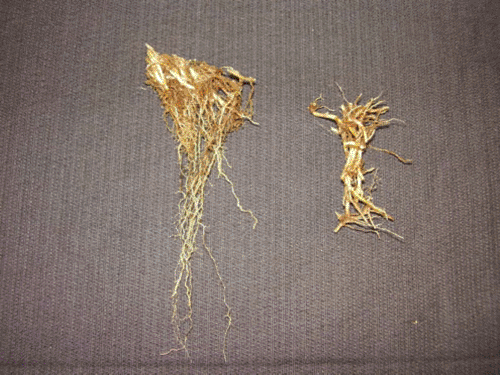First record of Hoplolaimus galeatus in Australia
L. Nambiar A C , M. Quader A and J. M. Nobbs BA Department of Primary Industries Victoria, 621 Burwood Highway, Knoxfield, Vic. 3180, Australia.
B South Australian Research and Development Institute Field Crops Nematology Unit, LMB 100, Glen Osmond, SA 5064, Australia.
C Corresponding author. Email: lila.nambiar@dpi.vic.gov.au
Australasian Plant Disease Notes 3(1) 145-146 https://doi.org/10.1071/DN08056
Submitted: 24 September 2008 Accepted: 3 November 2008 Published: 20 November 2008
Abstract
Hoplolaimus galeatus was identified in turf samples from New South Wales and Western Australia. This is the first record of this species of plant-parasitic nematode in Australia.
In 2006, turf decline was observed in two bowling greens in Stockton and Beresfield, New South Wales (NSW) and one bowling green in Capel, Western Australia (WA). Affected turf (Cynodon dactylon) showed symptoms of stunting and yellowing in patches. Turf soil and root samples were submitted from the infested areas for diagnosis of plant-parasitic nematodes. Examination of roots showed a damaged root system with a small number of feeder roots and majority of the root-tips dead (Fig. 1). Nematodes from the roots were extracted using a marceration–filtration technique (Fallis 1943) and from soil using the Whitehead tray method (Whitehead and Hemming 1965). Nematodes were counted, assessed, fixed in formalin–acetic acid fixative (4 : 1 v/v) (Hooper 1970) and then transferred to glycerol using Seinhorst’s (1959) technique. Permanent microscope slides were prepared for species identification and submitted (voucher nos VPRI 25747 and 25689 for NSW, and VPRI 25659, 25660, 25661, 25662, 25671, 25672, 25673 and 25674 for WA) to the Victorian Plant Pathology Herbarium reference collection of Department of Primary Industries, Knoxfield Centre, Victoria, Australia.

|
Nematode specimens were identified using characters described by Orton-Williams (1973) for Hoplolaimus galeatus and the key to the species of Handoo and Golden (1992). These included (a) the presence of four incisures in the lateral field with areolation over the greater part of the body length (Fig. 2), (b) the cephalic region with usually five cuticular rings (Fig. 3), (c) the presence of a post-rectal sac and (d) three gland nuclei.

|

|
The main morphological characters used to differentiate these three species are presented in Table 1. Hoplolaimus galeatus has a longer body and stylet length compared with H. pararobustus and H. seinhorsti. Hoplolaimus galeatus also has four areolated incisures in the lateral field while H. seinhorsti has only one complete incisure and H. pararobustus has variable incisures in the lateral field with 2–3 incomplete incisures occasionally seen. Roughly equal numbers of males are present in H. pararobustus and H. galeatus whereas males are not detected in H. seinhorsti.

|
This new record brings the number of species of Hoplolaimus present in Australia to three. The other two species of Hoplolaimus recorded from Australia are H. pararobustus and H. seinhorsti.
Acknowledgements
The authors would like to thank Sportsturf Consultants Pty Ltd, Vic. and Turfgrass Technology Pty Ltd, Vic. for submitting turf samples to Crop Health Services for nematode diagnosis. The species identification/verification of H. galeatus was the result of the ‘Australian Plant Pest Database/Data Capture and Validation’ project 2007–2008.
Fallis AM
(1943) Use of the Waring blender to separate small parasites from tissue. Canadian Journal of Public Health 34, 44.

Handoo ZA, Golden AM
(1992) A key and diagnostic compendium to the species of the genus Hoplolaimus Daday, 1905 (Nematoda: Hoplolaimidae). Journal of Nematology 24, 45–53.

Seinhorst JW
(1959) A rapid method for the transfer of nematodes from fixatives to anhydrous glycerine. Nematologica 4, 67–69.

Whitehead AG, Hemming JR
(1965) A comparison of some quantitative methods of extracting small vermiform nematodes from soil. The Annals of Applied Biology 55, 25–38.
| Crossref | GoogleScholarGoogle Scholar |



